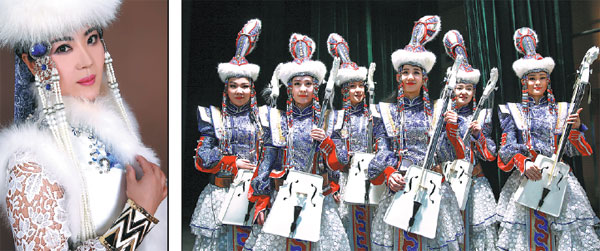Strings that sing Mongolian music's magical melodies
By Chen Nan (China Daily) Updated: 2017-02-07 07:26Two dozen young performers in colorful robes sweep bows across traditional Mongolian morin khuur (horse-head fiddles) at the Minzu University of China's theater.
Their nomadic melodies float through the air like the breezes across the grasslands.
It is their last show before the Chinese Lunar New Year.
The morin khuur ensemble Dongfang Shenjun (Oriental Steed) is known for original compositions and new presentations of old folk tunes from the Inner Mongolia autonomous region, from where its members hail. Their average age is 20.
The ensemble is the brainchild of 45-year-old singer Xiangdan, from Inner Mongolia's Bayannur city.
It breaks from the convention of performing while seated. Instead, its members stand and move around the stage, as if performing a choreographed dance, as they play their instruments.
"We not only give old melodies new sounds but also create a visual spectacle onstage," says Xiangdan.
"To see these people clad in traditional Mongolian attire while clutching morin khuur is a spectacle in itself - even without the music."
She recalls spending her childhood in different cities since her father was in the military.
But her love of the morin khuur was constant throughout her formative years.
"Ethnic Mongolians love morin khuur because its sound reminds us of home," she says.
Xiangdan learned to sing from a young age and started performing as a soprano with Harbin Opera Theater at 18.
She left the opera group to found the ensemble in 2005.
Xiangdan staged auditions to find Inner Mongolia's most talented young morin khuur players, whom she brought to the national capital for training under veteran instrumentalists and choreographers for the group's first two years in Songzhuang village on Beijing's outskirts.
Sun Yueting, whose stage name is Xiaogege, recalls: "We didn't just learn morin khuur but also underwent physical training because performing while moving around requires strength and endurance."
Members sling the instruments from their belts onstage.
Sun, who grew up in Inner Mongolia's Tongliao city, learned the erhu (two-stringed fiddle) from her grandfather from a very early age and started playing the morin khuur at a local art school from the age of 12.
She joined the ensemble at 16 after she saw it on TV. She was dazzled by its music and stage presence.
"The ensemble had about 10 students taking classes eight hours a day," the 25-year-old recalls.
Xiangdan brought several members to Mongolia to study khoomei, or throat-singing, about eight years ago. She learned kargyraa, a deeper-sounding khoomei style, which she performed with the ensemble.
Speaking of bassy sounds, Xiangdan also developed a large morin khuur. The big instrument is like the double bass in a Western symphony orchestra. The 1.6-meter instrument's two strings are formed by about 600 intertwined smaller strings.
The ensemble has enjoyed greater fame since it won the first CCTV National Chinese Instrumental Competition's Golden Award in 2007.
It performed at the Vienna Musikverein in 2009, the same year the group played at the Great Hall of the People for Barack Obama during his first official visit to China.
The group played for the CCTV Spring Festival Gala, one of the country's most viewed TV events, the following year. It toured the United States, Russia, Japan and Malaysia in 2012.
Dongfang Shenjun will create two short videos this summer. One will chronicle the ensemble's history. The other will elucidate ethnic Mongolians' relationship with horses.
"My vision is for youth from different cultures to perform morin khuur together in the ensemble," says Xiangdan.
Yuan Hui contributed to the story.
|
Xiangdan (left) and her ensemble, Dongfang Shenjun, have reached out to global audiences with their modern presentations of Mongolian folk tunes. Zou Hong / China Daily |
- 'Cooperation is complementary'
- Worldwide manhunt nets 50th fugitive
- China-Japan meet seeks cooperation
- Agency ensuring natural gas supply
- Global manhunt sees China catch its 50th fugitive
- Call for 'Red Boat Spirit' a noble goal, official says
- China 'open to world' of foreign talent
- Free trade studies agreed on as Li meets with Canadian PM Trudeau
- Emojis on austerity rules from top anti-graft authority go viral
- Xi: All aboard internet express












